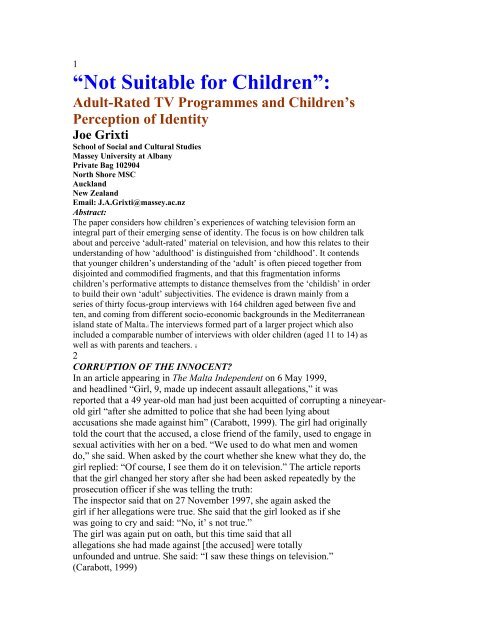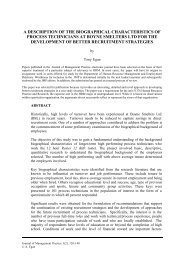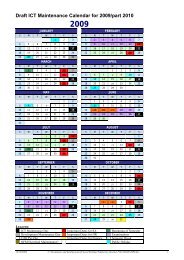“Not Suitable for Children”: Adult-Rated TV Programmes and ...
“Not Suitable for Children”: Adult-Rated TV Programmes and ...
“Not Suitable for Children”: Adult-Rated TV Programmes and ...
You also want an ePaper? Increase the reach of your titles
YUMPU automatically turns print PDFs into web optimized ePapers that Google loves.
1<br />
<strong>“Not</strong> <strong>Suitable</strong> <strong>for</strong> <strong>Children”</strong>:<br />
<strong>Adult</strong>-<strong>Rated</strong> <strong>TV</strong> <strong>Programmes</strong> <strong>and</strong> Children’s<br />
Perception of Identity<br />
Joe Grixti<br />
School of Social <strong>and</strong> Cultural Studies<br />
Massey University at Albany<br />
Private Bag 102904<br />
North Shore MSC<br />
Auckl<strong>and</strong><br />
New Zeal<strong>and</strong><br />
Email: J.A.Grixti@massey.ac.nz<br />
Abstract:<br />
The paper considers how children’s experiences of watching television <strong>for</strong>m an<br />
integral part of their emerging sense of identity. The focus is on how children talk<br />
about <strong>and</strong> perceive ‘adult-rated’ material on television, <strong>and</strong> how this relates to their<br />
underst<strong>and</strong>ing of how ‘adulthood’ is distinguished from ‘childhood’. It contends<br />
that younger children’s underst<strong>and</strong>ing of the ‘adult’ is often pieced together from<br />
disjointed <strong>and</strong> commodified fragments, <strong>and</strong> that this fragmentation in<strong>for</strong>ms<br />
children’s per<strong>for</strong>mative attempts to distance themselves from the ‘childish’ in order<br />
to build their own ‘adult’ subjectivities. The evidence is drawn mainly from a<br />
series of thirty focus-group interviews with 164 children aged between five <strong>and</strong><br />
ten, <strong>and</strong> coming from different socio-economic backgrounds in the Mediterranean<br />
isl<strong>and</strong> state of Malta.i The interviews <strong>for</strong>med part of a larger project which also<br />
included a comparable number of interviews with older children (aged 11 to 14) as<br />
well as with parents <strong>and</strong> teachers. ii<br />
2<br />
CORRUPTION OF THE INNOCENT?<br />
In an article appearing in The Malta Independent on 6 May 1999,<br />
<strong>and</strong> headlined “Girl, 9, made up indecent assault allegations,” it was<br />
reported that a 49 year-old man had just been acquitted of corrupting a nineyear-<br />
old girl “after she admitted to police that she had been lying about<br />
accusations she made against him” (Carabott, 1999). The girl had originally<br />
told the court that the accused, a close friend of the family, used to engage in<br />
sexual activities with her on a bed. “We used to do what men <strong>and</strong> women<br />
do,” she said. When asked by the court whether she knew what they do, the<br />
girl replied: “Of course, I see them do it on television.” The article reports<br />
that the girl changed her story after she had been asked repeatedly by the<br />
prosecution officer if she was telling the truth:<br />
The inspector said that on 27 November 1997, she again asked the<br />
girl if her allegations were true. She said that the girl looked as if she<br />
was going to cry <strong>and</strong> said: “No, it’ s not true.”<br />
The girl was again put on oath, but this time said that all<br />
allegations she had made against [the accused] were totally<br />
unfounded <strong>and</strong> untrue. She said: “I saw these things on television.”<br />
(Carabott, 1999)
What are we to make of this girl’ s claims <strong>and</strong> counter-claims? Who is<br />
the victim <strong>and</strong> who is the villain? Whatever the truth of the case may have<br />
been, there is clearly inscribed in the report, <strong>and</strong> in the court case as a whole,<br />
an assumption that the boundaries between “childhood” <strong>and</strong> “adulthood” had<br />
been transgressed. The girl’ s confusion about how to deal with a world of<br />
adult sexuality into which she has been thrown prematurely also speaks of<br />
her difficulty in knowing how to locate herself appropriately within received<br />
notions of childhood <strong>and</strong> adulthood. Irrespective of whether we take the girl<br />
to be an ingenuous victim of abuse, a desperate exploiter of adult concerns,<br />
or even a precocious Lolita, she still comes across as a child who has been<br />
robbed of her “childhood,” <strong>and</strong> betrayed by the adults who should have been<br />
protecting her innocence. Even in the version of the events in which the girl<br />
said that she had made up the allegations, she still comes across as a victim,<br />
not because of any specific evidence refuting other interpretations but<br />
3<br />
because she is seen as a child. If she is not a victim of the older man, then<br />
she is a victim of television, which allegedly filled her mind with images <strong>and</strong><br />
ideas which she was ill-equipped to underst<strong>and</strong> <strong>and</strong> cope with.<br />
The fact that the girl in this case identified television as the source of<br />
her apparently precocious knowledge of adult sexual behaviour raises serious<br />
questions about how young children are coping with the type of knowledge<br />
<strong>and</strong> in<strong>for</strong>mation to which they are daily exposed by the media. According to<br />
some writers, television has become an important sex educator <strong>for</strong> two major<br />
reasons: (i) its portrayals of sexuality are frequent, consistent, <strong>and</strong> they are<br />
usually assumed to be realistic by young people; (ii) there is a lack of<br />
alternative sources <strong>for</strong> learning about sexual behaviour (see Strasburger,<br />
1995: 38-45; <strong>and</strong> Roberts, 1982). As one group of US researchers put it,<br />
“ depictions of human sexuality are being consumed in reasonably large<br />
quantities [...] but useful <strong>and</strong> in<strong>for</strong>mative messages are not being conveyed<br />
to many young people” (Buerkel-Rothfuss et al, 1993:113). This has become<br />
more marked at a time when the boundaries of what is acceptable television<br />
fare have been pushed back considerably.<br />
A number of <strong>TV</strong> content analyses indicate that this pushing of<br />
boundaries is indeed incremental. The 1997 annual Monitoring Report<br />
published by the British Broadcasting St<strong>and</strong>ards Commission noted that<br />
there had been an increase in the inclusion of sexual scenes in “ soaps” ,<br />
confirming the continuation of a trend in popular <strong>TV</strong> programmes which had<br />
been identified in earlier studies. One such study, <strong>for</strong> instance, had analysed<br />
portrayals of sexual behaviours on prime time television programmes in the<br />
US in 1987, <strong>and</strong> compared these with findings from an identical study in<br />
1979, <strong>and</strong> found a generally higher rate of sexual behaviours per hour in<br />
1987 (Lowry <strong>and</strong> Toules, 1988). That study had also found that over the<br />
period under scrutiny there had been a substantial increase in the portrayal of<br />
sex between unmarried persons, with few attendant consequences. According<br />
to Gunter (1995:105), television provides young viewers with frequent<br />
lessons on how to look <strong>and</strong> act “ sexy,” while “ prime time dramas <strong>and</strong>
movies feature explicit portrayals of sex; magazine <strong>and</strong> talk shows feature<br />
intimate conversations about impotence <strong>and</strong> orgasms; situation comedies are<br />
filled with sexual innuendo <strong>and</strong> suggestiveness.” As a result, <strong>and</strong> in the<br />
absence of alternative sources of in<strong>for</strong>mation, “ the sexual lessons young<br />
4<br />
viewers derive from television foster an inaccurate image of sex that can lead<br />
to unrealistic expectations, frustration <strong>and</strong> dissatisfaction” (Gunter,<br />
1995:111, citing studies by Baran, 1976a, 1976b, <strong>and</strong> by Fern<strong>and</strong>ez-Collado<br />
et al. 1978).<br />
Gunter’ s account, like many discussions of children <strong>and</strong> the media,<br />
reflects more fundamental assumptions about the nature of childhood, which<br />
often appear to incorporate an image of “ the child” as somehow antedating<br />
the arrival of (or exposure to) television. But the definition of what it means<br />
to be a child has been subject to a considerable amount of social <strong>and</strong><br />
historical variation (see Ariès, 1960; James, 1993). Indeed, it can be argued<br />
that the fifty-odd years of concern about television’ s effects on children have<br />
helped to give rise to new variations in the definition of childhood —<br />
variations which exist only in the abstract or which only find embodiment as<br />
the perennially “ childish” other.<br />
LOCATING THE RESEARCH TRADITION<br />
One of the main contributions of ethnographic audience research<br />
since the 1970s has been its demonstration that media consumption is<br />
embedded in the routines, rituals <strong>and</strong> institutions of everyday life. Several<br />
studies have shown how the meanings of the media are inseparable from <strong>and</strong><br />
negotiated within these public <strong>and</strong> domestic contexts. Talking about<br />
television <strong>and</strong> the media more generally, there<strong>for</strong>e, inevitably also involves a<br />
social process of defining or positioning oneself <strong>and</strong> others, <strong>and</strong> such<br />
positioning is part of ongoing definitions <strong>and</strong> redefinitions of power <strong>and</strong><br />
social identity. Trying to make sense of how children talk about their<br />
experiences of television thus also involves trying to underst<strong>and</strong> how they<br />
define themselves <strong>and</strong> their social relations. Perceptions of <strong>and</strong> attitudes to<br />
differences in social class, gender, age, as well as regional <strong>and</strong> ethnic identity<br />
play a significant role in how children talk about their likes <strong>and</strong> dislikes, or<br />
even what they are willing to own up to when talking about television.<br />
The questions of how children perceive, interact with, <strong>and</strong> are<br />
influenced by television, radio <strong>and</strong> the media more generally have been hot<br />
topics of debate <strong>for</strong> a very long time. These are questions which usually<br />
arouse many strongly held views, emotions <strong>and</strong> preconceptions. The<br />
5<br />
preconceptions are likely to be deeply ingrained, <strong>and</strong> often not necessarily<br />
thought out logically. Television is so familiar to all of us: we not only all<br />
watch it, but most of us have also watched children watch it <strong>and</strong> noticed its<br />
effects on them (or what we have assumed to be its effects) with varying<br />
degrees of concern <strong>and</strong> condescension. We have also all heard the many<br />
stories (usually avidly reported by the media themselves) about “ copy-cat”<br />
crimes <strong>and</strong> other appalling things happening while children, young adults
<strong>and</strong> immature moral defectives were allegedly under the influence of the<br />
demon tube (see Murdoch, 1997; Petley, 1997; Hill, 1997).<br />
Popular notions of how screen portrayals of sex or violence might<br />
influence or affect viewers assume that the medium (television, most often)<br />
has the power to change young people’ s attitudes, perceptions, moods,<br />
inhibitions or feelings, <strong>and</strong> in some cases even to trigger or stimulate violent<br />
action or action which imitates what is seen. For all their insistence on the<br />
primacy of common sense in this sphere, many of these assertions about the<br />
power of example <strong>and</strong> imitation are backed by a large array of data <strong>and</strong><br />
reports of experimental studies conducted by adherents of various factions<br />
of learning <strong>and</strong> social learning theory in the social sciences. These were<br />
studies which set out to empirically test cause <strong>and</strong> effect connections<br />
between viewing <strong>and</strong> behaviour or attitudes (most notably in relation to<br />
violence <strong>and</strong> advertising), <strong>and</strong> which variously claimed to prove such<br />
connections through a range of processes — including arousal, imitation,<br />
desensitisation, disinhibition, ‘mainstreaming’ , distorting views about<br />
conflict resolution (see Lowery <strong>and</strong> DeFleur, 1995; Newton, 1996). Over<br />
recent years, a lot of doubt has been shed on the reliability of most of these<br />
studies, particularly in terms of (i) whether their findings could be claimed<br />
to apply beyond the specific conditions in which they had been conducted,<br />
<strong>and</strong>, more importantly, (ii) in terms of what have come to be recognised as<br />
the theoretically blinkered (positivist) methodologies <strong>and</strong> assumptions on<br />
which many of them were based (see Gunter, 1985; Grixti, 1989). As<br />
Graham Murdock (1997:69) uncompromisingly puts it, there was a<br />
circular relationship between empiricist science <strong>and</strong> common sense<br />
thinking [which] was built into academic work on media ‘effects’<br />
from the outset. The dominant research tradition adopted the<br />
definition of the ‘problem’ already established in popular <strong>and</strong><br />
6<br />
political commentary. The result was banal science, which failed to<br />
ask awkward questions, to pursue other possible lines of inquiry or to<br />
place ‘effects’ in their social contexts.<br />
The most influential studies of media audiences developed in recent<br />
years have placed their major emphasis on audiences as active interpreters<br />
<strong>and</strong> judges of media products, <strong>and</strong> on seeking to identify how viewers<br />
themselves define <strong>and</strong> make sense of what they watch. What unites this work<br />
is a view of children, not as passive recipients of television messages, but as<br />
active interpreters <strong>and</strong> processors of meaning. This emphasis has led to a<br />
movement away from research that concentrates upon whether or not the<br />
mass media confirm or disrupt the status quo, <strong>and</strong> towards a more concerted<br />
ef<strong>for</strong>t to take account of the symbolic nature of cultural meanings <strong>and</strong><br />
communication. As Virginia Nightingale (1996: ix) puts it, “ [i]nstead of<br />
measuring the effects of the media on people’ s behaviour, the effects were<br />
proposed to lie in people’ s lived relationship with popular texts.”<br />
One key influence in this approach was the social anthropologist<br />
Clif<strong>for</strong>d Geertz, particularly his insistence that what we call culture is the
web of signification that has been spun by meaningful actions. The analysis<br />
of culture, Geertz insisted, is “ not an experimental science in search of law<br />
but an interpretive one in search of meaning” (Geertz, 1973:5). Researchers<br />
have thus become more concerned with asking how different types of<br />
representations are perceived <strong>and</strong> interpreted, <strong>and</strong> how viewer responses<br />
relate to the cultural contexts in which they are produced. As Buckingham<br />
(1998: 142) puts it, “ viewers are seen here not as unique <strong>and</strong> coherent<br />
individuals, but as sites of conflict, ‘points of intersection’ between a variety<br />
of potentially conflicting discourses, which in turn derive from different<br />
social locations <strong>and</strong> experiences (<strong>for</strong> example, in terms of social class,<br />
gender <strong>and</strong> ethnicity).” The emphasis, then, is on trying to identify how<br />
meaning is constructed through social processes, <strong>and</strong> this inevitably involves<br />
taking account of the power-relationships which characterise them (see<br />
Hodge <strong>and</strong> Tripp, 1986).<br />
To ask <strong>and</strong> answer questions about the effects of television, we<br />
there<strong>for</strong>e have to see it as part of all the experiences <strong>and</strong> meaning-making<br />
activities of everyday life which we take <strong>for</strong> granted. Television has become<br />
7<br />
an integral part of family life. It can no longer be thought of as an external or<br />
intrusive <strong>for</strong>ce which (as one dark version has it) acts as an outside threat to<br />
family values, or (in the more optimistic account) has the potential of<br />
enhancing those values like a benevolent outsider. The extent to which<br />
television has become an inseparable component of family living is reflected<br />
in its positioning in the living, eating <strong>and</strong> sleeping areas of our homes; <strong>and</strong> in<br />
the fact that it is so often on when the family is doing other things. It has<br />
become part of the meanings <strong>and</strong> associations of those areas <strong>and</strong> activities.<br />
To quote Buckingham (1993:103) again, “ [t]elevision is not merely part of<br />
the mess of family life, or simply an appliance like a dishwasher or a vacuum<br />
cleaner. In considering ‘family viewing’ we are inevitably considering the<br />
operation of social power, both within <strong>and</strong> beyond the family itself.”<br />
One important methodological implication of this theoretical work is<br />
that what young people say when talking about the media cannot be taken at<br />
face value. This is so not only because there may be unconscious factors<br />
influencing what one is or is not aware of in patterns of media consumption,<br />
but also, <strong>and</strong> just as importantly, because “media tastes do not simply reflect<br />
identity, but are actually constitutive of it” (Seiter, 1999:29).<br />
<strong>TV</strong> TALK AS SELF-DEFINING PERFORMANCE<br />
In a series of publications based on extensive focus-group interviews<br />
with British children <strong>and</strong> their parents, David Buckingham (1993, 1996,<br />
1998) has variously argued that debates about what is or is not appropriate<br />
<strong>for</strong> children to watch on television are often more helpfully understood as<br />
debates about exactly how childhood is different from adulthood:<br />
In all societies, children’ s lives are largely bounded by the constraints<br />
imposed by adults — yet these constraints exist not merely in order<br />
to sustain adult power, but also in the name of protecting <strong>and</strong><br />
preserving a particular definition of childhood. It is perhaps not too
surprising, there<strong>for</strong>e, that the discourses which serve to define <strong>and</strong><br />
construct “ the child” should be subject to such intense <strong>and</strong> often<br />
contradictory negotiations. (Buckingham, 1996: 92)<br />
8<br />
Such negotiations are of course not limited to adults. Children<br />
usually see themselves as fitting somewhere along an imagined continuum<br />
from infancy to adulthood — as is evidenced by their preoccupation with the<br />
definition of what is “ childish” or “ adult,” not least in their discussions of<br />
television. Conflicts between parents <strong>and</strong> children about the appropriateness<br />
of watching particular films or programmes can thus be seen as<br />
disagreements about where on the continuum the child really belongs.<br />
Children’ s methods of distancing themselves from “ immaturity” <strong>and</strong><br />
“ childishness” often take the <strong>for</strong>m of claiming that while “ others” fall into<br />
such categories <strong>and</strong> should thus be shielded from exposure to “ adult” <strong>TV</strong><br />
content, they themselves are more “mature” . They thus often construct their<br />
self-images in opposition to this childish other. It serves as a measure of a<br />
perennially less mature stage of development against which they can<br />
distance themselves.<br />
Because of this concern, children’ s talk about adult-oriented material<br />
in films <strong>and</strong> <strong>TV</strong> often also takes on carnivalesque dimensions. The word<br />
“ carnivalesque” is used here in the sense suggested by the Russian literary<br />
critic Mikhail Bakhtin (1968), in order to draw attention to similarities with<br />
situations in which normal behavioural rules <strong>and</strong> expectations are loosened<br />
(as traditionally happens during the days of carnival), giving rise to dramatic<br />
changes in behaviour <strong>and</strong> discursive conventions. What is said <strong>and</strong> done in<br />
carnivalesque situations is largely inspired by the desire to test out how far<br />
boundaries can be pushed. Conventional behaviour <strong>and</strong> habitual social<br />
relations are typically reversed: servants take on the role of masters, <strong>for</strong><br />
instance, or men dress as women; but these unwonted roles are assumed in a<br />
manner which is conspicuously exaggerated. What is said <strong>and</strong> done in such<br />
situations thus becomes primarily a self-conscious <strong>and</strong> deliberate<br />
per<strong>for</strong>mance — one which while being entertaining <strong>and</strong> pleasurable, also<br />
allows those taking part a chance to experiment with roles which would<br />
normally be prohibited. The incongruity <strong>and</strong> absurdity of the switching of<br />
habitual roles are highlighted <strong>and</strong> underlined, partly to encourage laughter<br />
<strong>and</strong> ridicule, but also (paradoxically) to rein<strong>for</strong>ce the idea that this is only a<br />
temporary <strong>and</strong> outrageous reversal of what the participants <strong>and</strong> spectators<br />
assume to be the “ natural order” .<br />
9<br />
As indeed is the case with most adults, children <strong>and</strong> teenagers<br />
perceive the watching of television as a relaxing <strong>and</strong> recreational activity.iii<br />
Because of this, children often approach the watching of television as one<br />
area of experience where they can try out roles which they associate with<br />
being adult in a relatively safe <strong>and</strong> “ carnivalesque” fashion . It is not that<br />
they believe themselves to be adults, but that, <strong>for</strong> the purposes of the<br />
recreational activity of watching television, they believe themselves to be
capable of displaying the characteristics of “maturity” <strong>and</strong> lack of<br />
“ childishness” which distinguish adults from children. This carnivalesque<br />
element is also particularly apparent in the way children talk about adult (<strong>and</strong><br />
especially sexual) <strong>TV</strong> content in the presence of peers <strong>and</strong> adults. It becomes<br />
more pronounced in interview situations like those undertaken <strong>for</strong> this<br />
project because the children are being encouraged to speak openly about<br />
matters which are not usually considered strictly appropriate in a school<br />
setting, <strong>and</strong> they are being encouraged to do so by an adult figure of<br />
authority (the interviewer) who is obviously not en<strong>for</strong>cing normal<br />
restrictions on what can <strong>and</strong> cannot be said.<br />
Interpreting what children say in this type of context there<strong>for</strong>e needs<br />
to take serious account of the fact that when they speak about a subject like<br />
<strong>TV</strong> <strong>and</strong> sex, many children frequently slip into per<strong>for</strong>mance modes. Their<br />
per<strong>for</strong>mances can be a <strong>for</strong>m of what looks like frivolous entertainment<br />
(involving pleasurable daring or teasing); but they can also assume more<br />
earnest <strong>and</strong> serious dimensions. In the latter case, the aim appears to be that<br />
of projecting a preferred image of themselves as a “ non-childish” person<br />
who has not been unduly shocked or “ badly influenced” by the experience of<br />
watching such fare. It’ s worth stressing that the term “ per<strong>for</strong>mance” is used<br />
analogically here, <strong>and</strong> not in any negative sense. It is certainly not being<br />
suggested that children deliberately set out to deceive or to pretend to be<br />
something which they know to be untrue. Rather, what they are engaged in is<br />
trying to locate themselves within what they perceive as a desirable stage of<br />
growth <strong>and</strong> social relations, <strong>and</strong> testing out what being in such a location<br />
feels like. Thinking of their talk about sex <strong>and</strong> its representations in the<br />
media as a type of per<strong>for</strong>mance can help us get a bit closer to identifying<br />
what assumptions they make about the “ natural order” when they shape their<br />
particular “ per<strong>for</strong>mance” .iv<br />
10<br />
CHILDREN’S PERCEPTIONS OF “ADULT” RATINGS<br />
How then do younger children know when a particular programme is<br />
inappropriate <strong>for</strong> them to watch? And what do they take “ suitable <strong>for</strong> adults<br />
only” to mean? The simple answer, of course, is that they know they are not<br />
supposed to watch specific programmes or scenes because adults tell them<br />
— as when parents block them from watching, or when the television<br />
stations issue warnings or classification guides.v When the latter come with<br />
an explanation as to why the programme is unsuitable <strong>for</strong> children (e.g.<br />
violence, sexual scenes, offensive language, etc), children might be assumed<br />
to take this to mean that it is material so described which constitutes “ adult<br />
fare.” One possible consequence of this cognitive ascription of meanings<br />
<strong>and</strong> values might be that a precocious child wanting to act <strong>and</strong> sound “ adult”<br />
might well choose to watch <strong>and</strong>/or speak about such material in order to gain<br />
peer status, or even to outrage adults. Buckingham found this pattern in his<br />
interviews with children in Britain — a pattern which he interprets as<br />
<strong>for</strong>ming part of ongoing definitions <strong>and</strong> redefinitions of power <strong>and</strong> social<br />
identity (1993: 75).
Virtually all the children I interviewed in Malta were well aware of<br />
the signposting conventions used on television to indicate programme<br />
classifications (AO, PG, etc). They were very prompt to describe <strong>and</strong> explain<br />
the signposting systems used by various television networks, <strong>and</strong> most of the<br />
younger children claimed that they usually followed these. When they were<br />
asked how they knew whether a programme was suitable <strong>for</strong> them to watch<br />
in situations when signposts were not available, the children often said that<br />
they know they shouldn’ t be watching when there is too much fighting,<br />
when it gets too scary, or when there are too many “ rude bits.” What they<br />
meant by “ rude bits” often varied in detail, but the term was frequently used<br />
to describe portrayals of sexual activity (ranging from couples kissing to<br />
intercourse), as well as of nudity or near-nudity. The fact that many of the<br />
children knew so much about such programmes, <strong>and</strong> the ways in which they<br />
spoke about them, suggests that in many cases classification guidelines, <strong>and</strong><br />
children’ s own realisation that they should not be watching, do not in fact<br />
stop them from watching. When this was pointed out to them, they usually<br />
gave what they considered logical reasons <strong>for</strong> not following the guidelines<br />
— the ratings are not always reliable, it’ s OK to watch with your parents,<br />
11<br />
films are not so scary if you watch them during the day <strong>and</strong> on video, <strong>and</strong> so<br />
on.<br />
This inconsistency is partly attributable to lack of consistency in<br />
parental guidance. In my interviews, there were many stories told of one<br />
parent finding a programme unsuitable <strong>for</strong> children to watch, while the other<br />
made it obvious that he or she did not; of children hearing teachers<br />
condemning material which their parents regularly watched with them; or of<br />
children being allowed to watch programmes clearly vetoed by their parents<br />
when they stayed with their gr<strong>and</strong>parents or with other relatives or friends.<br />
Children often also reported staying up with their parents to watch<br />
programmes or films which were clearly designated as adult-rated. More<br />
importantly, the fact that most of the children said that they have more than<br />
one <strong>TV</strong> set at home, <strong>and</strong> that a significant number of them also have their<br />
own set in their bedroom, suggests that in many cases parental controls are<br />
as difficult to en<strong>for</strong>ce as they are erratic <strong>and</strong> ill defined.vi<br />
Many children were clearly curious about adult-rated material,<br />
perhaps because of the adult classification, which could also be seen as a<br />
signpost demarcating where the realms of “ adulthood” begin <strong>and</strong> those of<br />
childhood <strong>and</strong> the childish end. A number of older children pointed out that<br />
they often watched “ grown-up” programmes <strong>and</strong> could not see why they<br />
were rated “ adults only” — “ they weren’ t all that violent or scary,” they<br />
often insisted. Older children (i.e. ten to fourteen) often also argued that they<br />
should be allowed to watch adult-rated material dealing with sex-related<br />
issues because such material deals with “ real life” <strong>and</strong> they need to be<br />
prepared <strong>for</strong> this. They also appeared to get pleasure from watching material<br />
which they felt was providing them with in<strong>for</strong>mation about adult behaviour<br />
<strong>and</strong> themes which might normally be hidden from them. Ironically, the types
of programmes which the children I interviewed identified most frequently<br />
as fitting this category included soap operas <strong>and</strong> sc<strong>and</strong>al-mongering chat<br />
shows like Jerry Springer.<br />
There was also a marked contrast between the idealised images of<br />
responsible adulthood which many parents appeared to want their children to<br />
become familiar with, <strong>and</strong> the types of images of less-than-perfect adults<br />
which characterise many of the television programmes which were more<br />
12<br />
popular with children. One of the mothers I interviewed said that she does<br />
not allow her children to watch The Simpsons because it is “ unnatural.”<br />
When I asked her to explain, she referred to what she considered bad<br />
behaviour by the characters, the fact that they are always arguing, <strong>and</strong> that<br />
they use language which is both reprehensible <strong>and</strong> grammatically incorrect.<br />
Similar sentiments were expressed by a young father who said that he<br />
objected to the cartoon programme Cow <strong>and</strong> Chicken because the family<br />
situations depicted in it were not ideal <strong>and</strong> hence gave children “ the wrong<br />
ideas” about what family life should be like. A lot of the evidence from what<br />
children themselves say suggests that they like such programmes precisely<br />
because they break conventions <strong>and</strong> undermine the idealised world which<br />
children often see adults as trying to gull them into believing to be reality. In<br />
other words, children like such programmes partly because they assume<br />
them to be telling them more about life than their parents are willing to tell.<br />
Thus, <strong>for</strong> a child, being a child means being shielded.<br />
Joshua Meyrowitz has argued that children may love television<br />
precisely “ because it extends their horizons of experience, because it<br />
exp<strong>and</strong>s their awareness of adult behavior <strong>and</strong> adult roles, <strong>and</strong> because it<br />
keeps them abreast of the latest adult attempts to control them” (1995:45). In<br />
his book No Sense of Place, Meyrowitz (1985) ascribed this phenomenon to<br />
the fact that new media change patterns of access to in<strong>for</strong>mation. What a<br />
young child knew about the world was once determined primarily by where<br />
he or she lived <strong>and</strong> was allowed to go. Parents could mould their young<br />
children’ s upbringing by speaking <strong>and</strong> reading to them only about those<br />
things they wished them to be exposed to. By making it possible <strong>for</strong> children<br />
to have access to images <strong>and</strong> ideas over which their parents have little direct<br />
control, television has radically changed the patterns in which this happens.<br />
In this manner, Meyrowitz argues, television’ s visual nature <strong>and</strong> universal<br />
presence have broken down many traditional distinctions between adult <strong>and</strong><br />
child. By exposing children to the very topics that adults are trying to keep<br />
from them, television dilutes the authority of grown-ups <strong>and</strong> limits<br />
traditional systems of adult control. It even lets children in on the biggest<br />
secret of all, the secret of secrecy: that adults are conspiring to censor their<br />
knowledge<br />
13<br />
Forceful as Meyrowitz’ s argument is, it might be more accurate to<br />
say that, in a global media context dominated by commercial interests <strong>and</strong><br />
the dem<strong>and</strong>s of advertising, television is not so much exp<strong>and</strong>ing children’ s
underst<strong>and</strong>ing of adult behaviour <strong>and</strong> roles as introducing them to a complex<br />
<strong>and</strong> often confusing bricolage of images whose main unifying <strong>for</strong>ce is the<br />
fact that they are consumption-driven. In contexts where television has<br />
become “ primarily a vehicle <strong>for</strong> broadcasters to sell people to advertisers”<br />
(Allen, 1992: 18), both programme content <strong>and</strong> audiences become<br />
commodified. Children may assume that programmes are more “ truthful”<br />
when they are different from the idealised world which their parents would<br />
like them to take on board, <strong>and</strong> because adults designate such material as<br />
“ not suitable <strong>for</strong> children.” But the fact that the programmes contain<br />
material which subverts this ideal does not necessarily mean that they are<br />
more realistic, or that they give a more accurate picture of what adult life is<br />
all about. Further, as Judith Van Evra (1998: 45) points out, if the increased<br />
access to in<strong>for</strong>mation which television makes possible is coupled with<br />
children’ s greater likelihood of decoding in ways which are different from<br />
those used by adults, the potential <strong>for</strong> misinterpretation is greater. In effect,<br />
they are seeing, <strong>and</strong> trying to interpret, the adult world through children’ s<br />
eyes <strong>and</strong> with children’ s cognitive capacities.<br />
MAKING CHILDISH SENSE OF ADULT ISSUES<br />
Young children frequently choose not to watch adult-rated material<br />
(even when their parents do not actively stop them) because they simply are<br />
not interested in it. But this does not mean that they have no access to<br />
in<strong>for</strong>mation about “ adult” issues. In my interviews I came across several<br />
instances of younger children piecing in<strong>for</strong>mation together from fragments<br />
culled <strong>and</strong> integrated from different popular media, <strong>and</strong> then basing their<br />
claim to “ adult” knowledge on this piecemeal in<strong>for</strong>mation. Here is how one<br />
eight-year-old girl responded to my question as to whether she likes listening<br />
to radio:<br />
Sometimes, when the weather is on, I listen to it. And when there’ s<br />
songs, I listen to it, <strong>and</strong> there’ s my mother’ s favourite one. It’ s<br />
14<br />
about.. it’ s... well... she.. it’ s ... drums a lot. And at the end of it, she<br />
asks a man or whatever, I don’ t know what, <strong>and</strong> she asks, <strong>and</strong> she<br />
asks her, him: “Will you sleep with me?” At the end... It’ s like on In<br />
<strong>and</strong> Out. They’ re getting married <strong>and</strong> he says “ She’ s gay!” because<br />
this man kissed that man.[Interruptions] Wait! He was a video man.<br />
He, umm, like there’ s a video man, he takes a video of us... <strong>and</strong>, <strong>and</strong><br />
one day, when he was going to get married, he kissed him! The man<br />
kissed Kevin Kline!<br />
This girl is making sense of the words of her mother’ s favourite pop song<br />
through her underst<strong>and</strong>ing of another unusual situation which she saw (<strong>and</strong><br />
apparently found strange enough to remember vividly) in a popular movie.<br />
This apparently has been her introduction to the notion <strong>and</strong> existence of<br />
homosexuality. Intertextuality, <strong>and</strong> an ability to negotiate meanings through<br />
cross referencing discrete items from different entertainment-oriented media<br />
has become this girl’ s source of knowledge about this “ adult” subject.<br />
Even when they don’ t watch the adult-rated programmes themselves,
younger children often see trailers or promotional spots <strong>for</strong> them which<br />
frequently contain glimpses of scenes <strong>and</strong> details calculated to whet the<br />
appetite of older viewers. In one interview, a seven-year-old boy gave a very<br />
graphic description of scenes which he found very frightening <strong>and</strong> which<br />
came from a film which had been advertised as adult-rated. When I asked<br />
him whether he had seen the film, he replied emphatically that he had not,<br />
but he had seen “ a piece when they were telling when it would be.”<br />
Similarly, a group of eight-year-old girls gave graphic accounts of scenes or<br />
issues raised in the Jerry Springer Show <strong>and</strong> other sc<strong>and</strong>al-focussed chat<br />
shows which they insisted they had seen “ on adverts” (i.e. promotional<br />
slots), rather than watching the whole programme.<br />
This viewing of decontextualised snippets might well be more<br />
confusing or upsetting <strong>for</strong> children precisely because such snippets are by<br />
their nature calculated to arouse interest <strong>and</strong> curiosity. Their aim is<br />
frequently to titillate, tantalise or shock. They follow many of the attentiongrabbing<br />
conventions of advertising, <strong>and</strong> like adverts they are usually short,<br />
sharp <strong>and</strong> bitsy. They glamorise <strong>and</strong> sensationalise the everyday <strong>and</strong> the<br />
banal in order to attract viewers <strong>and</strong> sell products. In cases when the<br />
15<br />
publicity spots are also <strong>for</strong> programmes clearly marked as unsuitable <strong>for</strong><br />
children, such advertising conventions may well be encouraging children to<br />
develop ideas <strong>and</strong> images of “ adult” interests <strong>and</strong> tastes which are at best<br />
limited <strong>and</strong> at worst bizarre. Here is an eight-year-old boy’ s version of his<br />
parents’ viewing habits <strong>and</strong> his reactions to them. He made this statement as<br />
a way of “ showing up” or teasing another boy in his focus group who<br />
couldn’ t think of anything to say when I asked him which <strong>TV</strong> programmes<br />
he disliked:<br />
This one likes to watch those films where they keep kissing<br />
[laughter from other boys] <strong>and</strong> where they keep undressing<br />
[laughs] ... Like my dad! My dad [laughter from others] is really<br />
into it! .... [laughter]. And then my mum keeps watching men<br />
undressing ... That’ s what she likes ... And I no one. I only like to<br />
watch Play Station <strong>and</strong> cartoons. I play Play Station <strong>and</strong> watch<br />
cartoons....<br />
Another five-year-old boy described how he usually leaves the room when<br />
his parents watch “ adult” films <strong>and</strong> programmes:<br />
My mother used to watch a lot of films, <strong>and</strong> my father, but I don’ t<br />
like them, because daddy used to watch war films <strong>and</strong> things which<br />
don’ t like me, <strong>and</strong> sometimes he keeps switching [channels] all the<br />
time. So I just get up <strong>and</strong> leave him. And mummy sometimes<br />
watches Jerry Springer, but I don’ t like that one. I like Mowgli. I<br />
don’ t know what it’ s called — those which are scared of animals <strong>and</strong><br />
everything.<br />
Some children described how their parents often instruct them to<br />
cover their eyes during scenes which they do not wish them to see. A sevenyear-<br />
old boy delightedly described how he had peeked through his fingers
anyway when his father instructed him to do this during the scene in Titanic<br />
when Leonardo Di Caprio draws Kate Winslett in the nude. An eleven-yearold<br />
girl described how when she was younger, her older sister used to cover<br />
her (the girl’ s) eyes whenever there were any “ rude bits” . But most children<br />
frequently insisted that they themselves know <strong>and</strong> can judge <strong>for</strong> themselves<br />
whether something is suitable to watch or not — both <strong>for</strong> themselves <strong>and</strong> <strong>for</strong><br />
16<br />
younger children. A number in fact also told of how they regulate their<br />
younger siblings’ viewing because they are anxious <strong>for</strong> them not to be badly<br />
influenced. Here is a seven-year-old girl’ s description of how she monitors<br />
what her four-year-old brother is watching, even when her mother is<br />
apparently negligent (according to the girl’ s criteria, anyway) :<br />
My young brother, sometimes, umm, he watches... umm.. bad films,<br />
or he likes violent films, <strong>and</strong> when I come in the room <strong>and</strong> I see him<br />
watching them, I change the channel [laughs] to something like... he<br />
likes it, girl things.... ’Cause like, my mother was watching<br />
something violent, <strong>and</strong> she went to do something, <strong>and</strong> she left it on,<br />
<strong>and</strong> my brother was in the room, playing. Then he saw what’ s on the<br />
telly... I would come in, if I had, <strong>and</strong> really quick change the channel,<br />
’ cause I don’ t want my brother to start fighting with all his other<br />
friends <strong>and</strong> fight me!<br />
In the course of another interview with a mixed gender group of five<br />
year olds, Dustin <strong>and</strong> Samanthavii got into an extended debate with each other<br />
about the details of adult scenarios involving marital infidelity or domestic<br />
violence as they had seen them portrayed in the Maltese soap opera Ipokriti.<br />
Both were particularly keen on showing that they had a clear underst<strong>and</strong>ing<br />
of the issues involved, <strong>and</strong> their way of talking about these quickly<br />
developed into a kind of competition as to who had the better (<strong>and</strong> hence<br />
more “mature” ) underst<strong>and</strong>ing. Here is a translation of some of the things<br />
they said:<br />
Dustin Me, about Ipokriti, well, there was one gir... woman, <strong>and</strong> the<br />
woman, there was a man, her boyfriend... <strong>and</strong> this one was like a bit<br />
cruel, because he used to steal, that was his job. Well, she wore<br />
something, <strong>and</strong> they played a game [.....]<br />
Samantha No. That was a girl, <strong>and</strong> then there was.... [......]<br />
Dustin Yeah. But there was another woman who wanted to marry him.<br />
But he, he told some lie, <strong>and</strong> instead he married the other one. And<br />
then she started to get angry with him, because he didn’ t marry her.<br />
Samantha He did marry her!<br />
Dustin But, no, but, he told her “ all right” , but that was a lie. So then<br />
she.. he goes out with another woman...<br />
17<br />
Samantha No! He didn’ t marry anyone! That one, she... She was, she<br />
was already married. But he, her husb<strong>and</strong>, did not love her. He used to<br />
beat her [....]<br />
Dustin And he started hitting her. And so, then, she got him a black
eye ... The gir... I mean the woman, had a black eye, her husb<strong>and</strong> had<br />
hit her.....<br />
James She had a blow here, didn’ t she? An then a blow here...<br />
Samantha No, she started... she grabbed a gun <strong>and</strong> wanted to shoot<br />
him. Every day she wanted to shoot him. And then he gave her<br />
another beating <strong>and</strong> then she was going to shoot him again.... <strong>and</strong> she<br />
didn’ t find him...<br />
As already suggested, one striking aspect is the children’ s<br />
determination to show that they individually underst<strong>and</strong> what is happening in<br />
the programme they describe. In this sense, their debate takes on the<br />
characteristics of a per<strong>for</strong>mative display of cultural capital, <strong>and</strong> hence of<br />
“ adult status” . In line with Meyrowitz’ s argument about the blurring of<br />
distinctions between adults <strong>and</strong> children, what these children are engaged in<br />
can be read as a claim to an “ adult” role based on their access to <strong>and</strong><br />
assumed underst<strong>and</strong>ing of adult in<strong>for</strong>mation. There is, of course, something<br />
both incongruous <strong>and</strong> bizarre (carnivalesque) about the fact that these five<br />
year-old children are childishly arguing about the details of television<br />
portrayals of marital infidelity <strong>and</strong> domestic violence in order to prove that<br />
they are not “ childish” . The incongruity is well captured in Dustin’ s attempts<br />
to sound “ adult” by describing adult themes in childish language (as in his<br />
reference to the “ job” of being a thief, or in his allusions to the “ game”<br />
played by the characters). That incongruity became more marked in the<br />
interview when the other five year-old children in the group (who were not<br />
regular watchers of the soap opera) insisted on giving examples of their own<br />
“ grown up” tastes <strong>and</strong> lack of “ childishness” . One described how he used to<br />
enjoy Teletubbies but is now off it because he doesn’ t like hearing them talk<br />
like babies all the time; another announced that she had seen two scary films<br />
(one about dinosaurs, the other about James Bond) but that they weren’ t<br />
scary <strong>for</strong> her; <strong>and</strong> a third suddenly announced that her family was going to<br />
have a baby!<br />
18<br />
These children had been told repeatedly that this programme was<br />
meant <strong>for</strong> adult viewing. Their response to this is to talk extensively about its<br />
“ adult” aspects in order to show that they have a clear underst<strong>and</strong>ing of why<br />
it is not suitable <strong>for</strong> children. Indeed, when I pointed out to them that some<br />
teachers had told me that the serial should not be watched by children, they<br />
did not challenge this but said they agreed because of all the fighting which<br />
it contained. What these <strong>and</strong> other children who watched the programme<br />
regularly appeared to be doing was putting themselves on the side of<br />
responsible adults (the teachers) by drawing attention to the parts which they<br />
assumed were not good <strong>for</strong> children, but at the same time somehow<br />
exempting themselves from that classification by also proving that they are<br />
not themselves “ childish” . The per<strong>for</strong>mance in this case involves a more<br />
deliberate attempt to take on what the children think of as a “ grown-up” role.<br />
They are taking on the role of responsible adults, but their underst<strong>and</strong>ing of<br />
what this involves is limited <strong>and</strong> fragmented.
As is the case with adults, children often believe that <strong>TV</strong> can indeed<br />
harm children, but only those who are younger than themselves. Whenever I<br />
asked children of different ages whether they thought television could be<br />
harmful to children, I was either told that yes it would, if you sat too close to<br />
the set, or else that younger children than themselves (even the five year<br />
olds) were likely to be affected badly because they would want to imitate<br />
what they saw. Over <strong>and</strong> over again I was told the story (or variations of it)<br />
of the small boy who tried to imitate Superman by jumping out of the<br />
window to his death. Many had stories to tell about neighbours’ children<br />
(usually boys) or cousins, or other boys in the school, who were very badly<br />
behaved or were always fighting <strong>and</strong> copying all the violence they saw on<br />
<strong>TV</strong>. There were also frequent tales told of children in other countries<br />
(especially Britain <strong>and</strong> the US) being so badly influenced that they even<br />
started killing.<br />
Interestingly, whenever I asked the children I interviewed if they<br />
thought that they themselves had ever been influenced in these ways, they<br />
always said that they had not. In one interview, I told a group of 5-6 yearolds<br />
that older children had told me that children of their age were likely to<br />
imitate what they saw on television, especially fighting. Was this true?<br />
They all chanted “No!” What about the stories about children of their age<br />
19<br />
thinking they were Superman <strong>and</strong> jumping out of the window, then? Was<br />
this true? Again they said “ no” , <strong>and</strong> one of them explained that those who<br />
say this might get the wrong idea because they see them playing at this.<br />
Another group of six year-old boys with whom I had just been watching an<br />
episode of the cartoon Spiderman told me that they enjoy playing at<br />
superheroes <strong>and</strong> wearing Batman <strong>and</strong> Superman costumes. When I asked<br />
whether they had ever thought of “ flying” out of a window on such<br />
occasions, they all laughed <strong>and</strong> said that they wouldn’ t want to end up in<br />
hospital or in a coffin!viii<br />
For these children then, as <strong>for</strong> their parents, the child who is<br />
negatively influenced by television is always “ other.” Because children<br />
regularly see themselves excluded from watching particular types of<br />
programmes because of their “ child” designation, it is perhaps not surprising<br />
that this is one designation which they learn quickly to deflect away from<br />
themselves. According to Ellen Seiter (1999: 130), “ people always compare<br />
their own television viewing to that of the imagined mass audience, one that<br />
is more interested, more duped, more entertained, more gullible than they<br />
themselves.” This is a frequently repeated claim (cf Barker <strong>and</strong> Petley,<br />
1997). But when the children I interviewed were asked to describe specific<br />
instances involving “ negative” influence, they did so in ways which<br />
indicated that they thought that it was this more vulnerable <strong>and</strong> more gullible<br />
“ other” which was the minority, <strong>and</strong> that they themselves were really part of<br />
a more enlightened mass. They usually assumed that their peers <strong>and</strong> most<br />
children of their age <strong>and</strong> gender normally shared their advanced stage of<br />
enlightenment. In cases when they defended their rights to watch adult-rated
programmes, <strong>for</strong> instance, this was usually done in the <strong>for</strong>m of an assertion<br />
of their age group’ s maturity <strong>and</strong> ability to deal with such material — not as<br />
one individual’ s claim to being more “ adult” than his peers.<br />
When children rationalise their behaviour in watching programmes<br />
which they know to be designated as “ not suitable <strong>for</strong> children,” it is not so<br />
much the designation itself which they contest, but their own ability to judge<br />
<strong>for</strong> themselves — an ability which they want to be recognised as an<br />
indication of their more “ adult” status. As we have seen, they also take on<br />
“ adult” roles by shielding their younger siblings from watching material<br />
which they themselves designate as “ not suitable <strong>for</strong> children.” This is their<br />
20<br />
way of lifting themselves up the “maturity” scale <strong>and</strong> distancing themselves<br />
from “ childishness.” In doing this, they are also helping to perpetuate<br />
established assumptions about the parameters distinguishing childhood from<br />
adulthood.<br />
CONCLUSION<br />
I started with an account of how a nine year-old girl’ s claim that she<br />
was sexually abused was allegedly based on what she had seen on television.<br />
Can we draw any links between that story <strong>and</strong> the different ways in which<br />
various groups of children have been quoted as talking about adult-oriented<br />
material on television <strong>and</strong> films? One clear similarity lies in the fact that all<br />
appear to be examples of children trying to deal with apparently precocious<br />
“ adult” knowledge by taking on “ adult” roles in ways which look premature.<br />
It is clear that young children are being introduced to some <strong>for</strong>ms of adultoriented<br />
<strong>and</strong> sexually explicit material at a very early age. It is also clear that,<br />
however vigilant many parents are trying to be in order to protect their<br />
children from exposure to such fare, the reality is that children will almost<br />
inevitably come across at least glimpses or snatches of such material while<br />
watching television — e.g. during promotional spots or advertising breaks.<br />
For some children, these glimpses can become the building blocks out of<br />
which they construct their own bricolage of “ knowledge” about adult<br />
themes.<br />
What is also clear is that, partly because the reactions of adults to<br />
such fare are often inconsistent, embarrassed or evasive, some children come<br />
to use talk about it as a <strong>for</strong>m of cultural capital. They use such talk as a way<br />
of being outrageous, or as a way of showing that they are not “ childish” .<br />
What they appear to be saying is: “ I know this programme is ‘not suitable <strong>for</strong><br />
children’ <strong>for</strong> the following reasons, <strong>and</strong> my ability to underst<strong>and</strong> this proves<br />
my exemption from that classification!” This is not unlike the comment<br />
made by a number of children in relation to scary material when they say: “ it<br />
was a scary film, but I wasn’ t scared!” Another way in which children use<br />
talk about sexually related material is as part of what I have described as<br />
carnivalesque per<strong>for</strong>mances. This is also part of children’ s way of<br />
experimenting with what types of roles they can assume in different social<br />
21<br />
settings, <strong>and</strong> of testing out the extents to which they will be allowed to
assume “ adult” roles <strong>and</strong> “ adult” social relations. In this sense, children’ s<br />
talk about the adult material they encounter on television can be read as a<br />
testing of boundaries, <strong>and</strong> an exploration of what types of impact they can<br />
have on adults, siblings <strong>and</strong> peers. This is why they often try to prove that<br />
they are not “ childish” by talking about such material in one of several<br />
modes — outrageously, carnivalesquely, earnestly.<br />
Buckingham (1996: 80) has suggested that what lies at the root of<br />
much popular as well as academic concern about the negative effects of the<br />
media on children are dominant constructions of childhood which define<br />
children largely in terms of what they lack. This lack manifests itself in<br />
“ negative” qualities (vulnerability, ignorance, irrationality) which are also<br />
seen as an inability (or unwillingness) to con<strong>for</strong>m to adult norms. By<br />
implication, children wanting to distance themselves from the “ childish”<br />
there<strong>for</strong>e stress that they do not share this lack. But the defining of<br />
subjectivities through the negation of lack is likely to lead to confusion when<br />
adequate alternative concepts of “ adult” remain so fragmented. It is<br />
precisely through a willingness <strong>and</strong> even eagerness to appropriate norms<br />
which they underst<strong>and</strong> to be “ adult” that children usually distance<br />
themselves from the “ lack” which characterises the “ childish” <strong>and</strong><br />
“ immature.” As I have suggested, one problem with the ways in which this<br />
appropriation takes place in contemporary media cultures is that younger<br />
children’ s underst<strong>and</strong>ing of the “ adult” world which they assume their<br />
parents to be shielding them from is often pieced together from disjointed<br />
glimpses of sensationalised <strong>and</strong> consumption-oriented material. In this<br />
sense, it is on fragmented <strong>and</strong> disjointed notions of what it means to be an<br />
adult that these children are building their own “ adult” subjectivities.<br />
REFERENCES<br />
Allen, Robert C. (ed) (1992) Channels of Discourse, Reassembled. London:<br />
Routledge.<br />
Ariès, Philippe (1960) Centuries of Childhood: A Social History of Family<br />
Life. Harmondsworth: Penguin.<br />
22<br />
Bakhtin, Mikhail (1968) Rabelais <strong>and</strong> His World, translated by Helene<br />
Iswolsky. Cambridge, Mass: MIT Press.<br />
Baran, S.J. (1976a) Sex on <strong>TV</strong> <strong>and</strong> Adolescent Self-Image. Journal of<br />
Broadcasting 20.1 61-68.<br />
Baran, S.J. (1976b) How <strong>TV</strong> <strong>and</strong> Film Portrayals Affect Sexual Satisfaction<br />
in College Students. Journalism Quarterly 53.3 : 468-473.<br />
Barker, Martin <strong>and</strong> Petley, Julian (eds) (1997) Ill Effects: the Media<br />
Violence Debate. London <strong>and</strong> New York: Routledge.<br />
Barnouw, E., Dizard, W. P. <strong>and</strong> Guback, T. (1989) Television History. In E.<br />
Barnouw, G. Gerbner, W. Schramm, T.L. Worth, <strong>and</strong> L. Gross (eds),<br />
International Encyclopedia of Communications, Volume 4. New York:<br />
Ox<strong>for</strong>d University Press, 216-227.<br />
Broadcasting St<strong>and</strong>ards Commission (1997) Monitoring Report 6. London:<br />
Broadcasting St<strong>and</strong>ards Commission.
Buckingham, David (1993) Children Talking Television: The Making of<br />
Television Literacy. London: Falmer.<br />
Buckingham, David (1996) Moving Images: Underst<strong>and</strong>ing Children’s<br />
Emotional Responses to Television. Manchester <strong>and</strong> New York:<br />
Manchester University Press.<br />
Buckingham, David (1998) Children <strong>and</strong> Television: A Critical Overview of<br />
the Research. In R. Dickinson, R. Harindranath <strong>and</strong> O. Linné (eds)<br />
Approaches to Audiences: A Reader. London: Arnold.<br />
Buerkel-Rothfuss, N.L., Strouse, J.S., Pettey, G., <strong>and</strong> Shatzer, M. (1993)<br />
Adolescents’ <strong>and</strong> Young <strong>Adult</strong>s’ Exposure to Sexually Oriented <strong>and</strong><br />
Sexually Explicit Media. In B. S. Greenberg, J.D. Brown, <strong>and</strong> N.<br />
Buerkel-Rothfuss (eds) Media, Sex <strong>and</strong> the Adolescent. Cresskill, New<br />
Jersey: Hampton Press.<br />
Butler, Judith (1990) Gender Trouble: Feminism <strong>and</strong> the Subversion of<br />
Identity. New York <strong>and</strong> London: Routledge.<br />
Butler, Judith (1993) Bodies that Matter: On the Discursive Limits of ‘Sex’.<br />
New York <strong>and</strong> London: Routledge.<br />
Carabott, Michael (1999) Girl, 9, Made Up Indecent Assault Allegations.<br />
The Malta Independent (6 May), 4.<br />
Davies, Máire Messenger (1997) Fake, Fact, <strong>and</strong> Fantasy: Children’s<br />
Interpretations of Television Reality. Mahwah, New Jersey: Lawrence<br />
Erlbaum Associates.<br />
Fern<strong>and</strong>ez-Collado, C.F., Greenberg, B.S., Korzenny, F. <strong>and</strong> Atkin, C.K.<br />
(1978) Sexual Intimacy <strong>and</strong> Drug Use in <strong>TV</strong> Series. Journal of<br />
Communication, 28.3: 30-37.<br />
Fiske, John (1989) Reading the Popular. London <strong>and</strong> New York: Routledge.<br />
Geertz, Clif<strong>for</strong>d (1973) The Interpretation of Cultures. New York: Basic<br />
Books.<br />
Grixti, Joe (2000) Young People <strong>and</strong> the Broadcasting Media: The Maltese<br />
Experience. Hamrun: Malta Broadcasting Authority.<br />
23<br />
Grixti, Joe (1998) Normalising the Unspeakable: Media Portrayals of<br />
Violence in the Society of the Spectacle. New Zeal<strong>and</strong> Journal of<br />
Media Studies, 5.1: 3-12.<br />
Grixti, J. (1989) Terrors of Uncertainty: The Cultural Contexts of Horror<br />
Fiction. London <strong>and</strong> New York: Routledge.<br />
Gunter, Barrie (1985) Dimensions of Television Violence. Aldershot:<br />
Gower.<br />
Gunter, Barrie (1995) Television <strong>and</strong> Gender Representation . London: John<br />
Libbey.<br />
Hall, Stuart (1980) Encoding/Decoding. In S.Hall, D.Hobson, A.Lowe <strong>and</strong><br />
P.Willis (eds) Culture, Media, Language. London: Hutchinson.<br />
Hill, Annette (1997) Shocking Entertainment: Viewer Response to Violent<br />
Movies. Luton: University of Luton Press.<br />
Hodge, Bob, <strong>and</strong> Tripp, David (1986) Children <strong>and</strong> Television: A Semiotic<br />
Approach. Cambridge: Polity Press.
hooks, bell (1992) Black Looks: Race <strong>and</strong> Representation. Boston: South<br />
End Press.<br />
James, A. (1993) Childhood Identities. Edinburgh: Edinburgh University<br />
Press.<br />
Jenkins, Henry (1992) Textual Poachers: Television Fans <strong>and</strong> Participatory<br />
Culture. New York <strong>and</strong> London: Routledge.<br />
Josephson, Wendy L. (1995) Television Violence: A Review of the Effects on<br />
Children of Different Ages. Toronto: Department of Canadian Heritage,<br />
Ministry of Public Works <strong>and</strong> Government Services. Reprinted on the<br />
internet by the Media Awareness Network at:<br />
www.media-awareness.ca/eng/issues/violence/resource/reports/<br />
Lowery, S. A., <strong>and</strong> DeFleur, M. L. (1995) Milestones in Mass<br />
Communication Research: Media Effects, 3rd Edn. New York:<br />
Longman.<br />
Lowry, D.T. <strong>and</strong> Toules, D.E. (1988) Primetime <strong>TV</strong> Portrayals of Sex,<br />
Contraception <strong>and</strong> Venereal Diseases. Journalism Quarterly, 66: 347-<br />
352.<br />
Meyrowitz, Joshua (1995) Mediating Communication: What Happens? In J.<br />
Dowling, A. Mohammadi <strong>and</strong> A. Srebery-Mohammadi (eds)<br />
Questioning the Media: A Critical Introduction. Thous<strong>and</strong> Oaks: Sage.<br />
Meyrowitz, Joshua (1985) No Sense of Place: The Impact of Electronic<br />
Media on Social Behavior. New York: Ox<strong>for</strong>d University Press.<br />
Morley, David (1980) The ‘Nationwide’ Audience. London: British Film<br />
Institute.<br />
Murdock, Graham (1997) Reservoirs of Dogma: An Archaeology of Popular<br />
Anxieties. In M. Barker <strong>and</strong> J.Petley (eds) ll Effects: The<br />
Media/Violence Debate. London <strong>and</strong> New York: Routledge.<br />
Newton, David E. (1996) Violence <strong>and</strong> the Media: A Reference H<strong>and</strong>book.<br />
Santa Barbara: ABC-CLIO.<br />
Nightingale, Virginia (1996) Studying Audiences. London <strong>and</strong> New York:<br />
Routledge.<br />
24<br />
Pearson, Geoffrey (1984) Falling St<strong>and</strong>ards: A Short, Sharp History of Moral<br />
Decline. In M. Barker (ed) The Video Nasties. London: Pluto.<br />
Petley, Julian (1997) In Defence of ‘Video Nasties.’ In T. O’ Sullivan <strong>and</strong> Y.<br />
Jewkes (eds) The Media Studies Reader. London: Arnold.<br />
Real, Michael R. (1996) Exploring Media Culture: A Guide. Thous<strong>and</strong><br />
Oaks: Sage.<br />
Roberts, E. (1982) Television <strong>and</strong> Sexual Learning in Childhood. In D.Pearl,<br />
L.Bouthilet <strong>and</strong> J.Lazar (eds) Television <strong>and</strong> Behaviour: Ten Years of<br />
Scientific Progress <strong>and</strong> Implications <strong>for</strong> the Eighties. Rockville.<br />
Maryl<strong>and</strong>: National Institute of Mental Health.<br />
Seiter, Ellen (1999) Television <strong>and</strong> New Media Audiences. Ox<strong>for</strong>d:<br />
Clarendon Press.<br />
Springhall, John ( 1998) Youth, Popular Culture <strong>and</strong> Moral Panics: Penny<br />
Gaffs to Gangsta-Rap, 1830-1996. New York: St Martin’ s Press.
Strasburger, Victor C. (1995) Adolescents <strong>and</strong> the Media: Medical <strong>and</strong><br />
Psychological Impact. Thous<strong>and</strong> Oaks: Sage.<br />
Van Evra, Judith (1998) Television <strong>and</strong> Child Development (2nd Edn). New<br />
Jersey <strong>and</strong> London: Erlbaum.<br />
NOTES<br />
i<br />
The Maltese broadcasting l<strong>and</strong>scape is a complex mixture of staunch<br />
insularity <strong>and</strong> “ global village” orientations. Malta’ s 380,000 inhabitants are<br />
keen watchers of television, through which they have access to an<br />
increasingly broad range of both local <strong>and</strong> <strong>for</strong>eign transmissions. Access to<br />
Italian television transmissions has been available in Malta since these were<br />
started in the 1950s. A local state owned television station was set up in<br />
1961, <strong>and</strong> this has been transmitting locally produced programmes in<br />
Maltese as well as a large proportion of programmes imported from Britain<br />
<strong>and</strong> the US since then (cf Barnouw et al, 1989: 226). With the official<br />
introduction of pluralism in broadcasting in the early 1990s, the number of<br />
local free-to-air television stations has grown from one to five (two stations<br />
are owned <strong>and</strong> run by the two major political parties). This remains<br />
complemented by access to a broad range of stations broadcasting from Italy,<br />
including the three state run RAI stations, Silvio Berlusconi’ s three<br />
commercial channels, as well as a number of other private or regional<br />
networks. A local cable television network has been in operation <strong>for</strong> about<br />
six years, offering up to fifty-two channels from different parts of Europe<br />
(including the local <strong>and</strong> Italian free-to-air channels), but dominated mainly<br />
by British <strong>and</strong> American offerings. A considerable number of people have<br />
also invested in satellite dishes which allow them potential access to an even<br />
larger range of <strong>TV</strong> channels from all over the world.<br />
ii The project was commissioned by the Broadcasting Authority of Malta.<br />
The book version of the full report is entitled Young People <strong>and</strong> the<br />
Broadcasting Media: The Maltese Experience (Grixti, 2000).<br />
25<br />
iii A 1995 report published by the Department of Canadian Heritage argues<br />
that it is common <strong>for</strong> young children to watch television <strong>for</strong> relaxation,<br />
amusement or just to pass the time, while <strong>for</strong> adolescents “watching<br />
television is a passive, relaxing activity requiring low concentration, <strong>and</strong><br />
they are most likely to do it when they are bored or lonely (much the same<br />
way adults do)” (Josephson, 1995:17, 27). Similar patterns were recorded in<br />
Malta (Grixti 2000).<br />
iv The notion that identity <strong>and</strong> subjectivity are per<strong>for</strong>mative concepts has been<br />
extensively theorised by Judith Butler (1990, 1993), who argues that<br />
different kinds of per<strong>for</strong>mances of masculinity <strong>and</strong> femininity tend to find<br />
legitimation in different cultural contexts. For Butler “ sexuality” <strong>and</strong> sexual<br />
identity are a “ per<strong>for</strong>mance” of gender, in that they are based on repeated<br />
per<strong>for</strong>mances of bodily genres. Gendered bodies, she argues, “ are so many<br />
‘styles of the flesh’ ,” <strong>and</strong> gender is “ both intentional <strong>and</strong> per<strong>for</strong>mative,<br />
where ‘per<strong>for</strong>mative’ suggests a dramatic <strong>and</strong> contingent construction of
meaning” (1990:139).<br />
v How these guidelines are understood <strong>and</strong> interpreted by children need not<br />
coincide with what is intended by those who issue them of course. The<br />
notion that groups or individual viewers decode <strong>and</strong> restructure meanings in<br />
ways which may not be parallel with those intended by the programme’ s<br />
producers lies behind a lot of research into “ the active audience” conducted<br />
since the 1980s, <strong>and</strong> largely inspired by Stuart Hall’ s “ encoding/decoding”<br />
model (Hall, 1980). Interesting applications of this notion can be found in<br />
David Morley’ s “Nationwide” studies (1980), in Henry Jenkins’ s account of<br />
science fiction fans as “ textual poachers” (Jenkins, 1992), <strong>and</strong> in the<br />
different accounts given by John Fiske (1989) <strong>and</strong> bell hooks (1992) of the<br />
meanings which the pop star Madonna has <strong>for</strong> her fans.<br />
vi 78% of all the children surveyed in Malta said that they have more than<br />
one <strong>TV</strong> set at home. The most likely locations are the living room, parents’<br />
bedrooms <strong>and</strong> children’ s own or their siblings’ bedrooms. Those who said<br />
that they regularly watch <strong>TV</strong> in their own bedrooms tended to belong to the<br />
older age groups (10 years <strong>and</strong> over), <strong>and</strong> they were also a minority (15% of<br />
the total sample). For most, the “ family set” is where they do most of their<br />
watching.<br />
vii Names have been changed to protect confidentiality. In this interview,<br />
Dustin <strong>and</strong> Samantha described their fathers’ occupations as motor mechanic<br />
<strong>and</strong> soldier, <strong>and</strong> the mothers’ as seamstress <strong>and</strong> cleaner. The other children in<br />
the group had described their parents’ occupation as nurse, “ computing” , <strong>and</strong><br />
housewife. One child did not know.<br />
viii For discussions of children’ s underst<strong>and</strong>ing of distinctions between<br />
reality <strong>and</strong> fantasy see Davies (1997), Hodge <strong>and</strong> Tripp (1986), Grixti (1998,<br />
2000).

















